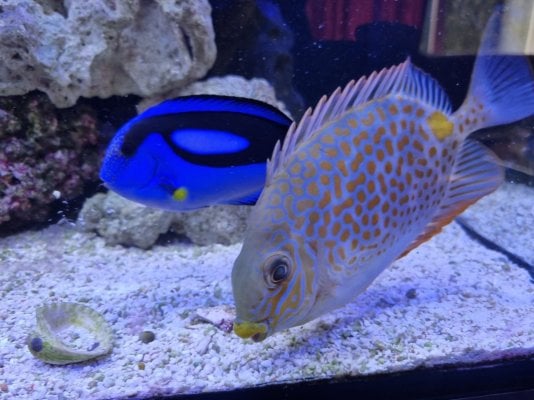Heyya, so im technically not new, ive been peeking on this website for years when i had questions but just now decided to join haha
Anyways, ive been into this hobby for 6 years, im 22 btw. My road was from 50l to 100l to 240l and now im at 450litre. It went incredibly well until i had to emergency visit my grandparents 2700km away for 2 weeks a few months ago.
A family member took care of my fish while i was gone but sadly one of my fish got the white dot parasite, femsal wasnt strong enough and now i only have 2 left and 3 hermits, 1 snail. (ill add an image of em, the big one likes to be pet. No joke) i dont wanna add more until the green algea problem is gone
and now i only have 2 left and 3 hermits, 1 snail. (ill add an image of em, the big one likes to be pet. No joke) i dont wanna add more until the green algea problem is gone
I dont have alot of corals since they always seemed to die so i didnt have em for a couple of years until i thought i was experienced enough and got more knowledge. ive got a few for a year now now they are THRIVING(taking it slow though) one of the corals I thought had died 4 years ago is growing back to my suprise as i noticed while cleaning the tank (green zoanthus, image added in this threat, u can see em a bit blurry in the middle of the stone)
But on the other side is this yellow substance, is this sponge?? If so do i need to remove the piece of rock where the corals are growing so the sponge leaves it alone or can i leave it like this? Never had this situation before, the sponges in my older tank were pink-ish
So my questions in short : is the yellow part sponge? Is it harmfull to the growing coral?
And what do I do with the green algea? I didnt have any problem with it since 3 years until recently. Ive tried everything, from water changes often to all kinds of brands to help reduce it, i feed my two fish half a sheet of nori seaweed once every 2 days and a little bit of granules(not sure if thats the right word) in the day between.
So yeah any advice would be appreciated!



Anyways, ive been into this hobby for 6 years, im 22 btw. My road was from 50l to 100l to 240l and now im at 450litre. It went incredibly well until i had to emergency visit my grandparents 2700km away for 2 weeks a few months ago.
A family member took care of my fish while i was gone but sadly one of my fish got the white dot parasite, femsal wasnt strong enough
I dont have alot of corals since they always seemed to die so i didnt have em for a couple of years until i thought i was experienced enough and got more knowledge. ive got a few for a year now now they are THRIVING(taking it slow though) one of the corals I thought had died 4 years ago is growing back to my suprise as i noticed while cleaning the tank (green zoanthus, image added in this threat, u can see em a bit blurry in the middle of the stone)
But on the other side is this yellow substance, is this sponge?? If so do i need to remove the piece of rock where the corals are growing so the sponge leaves it alone or can i leave it like this? Never had this situation before, the sponges in my older tank were pink-ish
So my questions in short : is the yellow part sponge? Is it harmfull to the growing coral?
And what do I do with the green algea? I didnt have any problem with it since 3 years until recently. Ive tried everything, from water changes often to all kinds of brands to help reduce it, i feed my two fish half a sheet of nori seaweed once every 2 days and a little bit of granules(not sure if thats the right word) in the day between.
So yeah any advice would be appreciated!


























